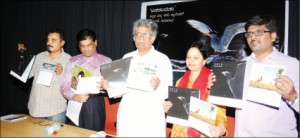Bangalore :
Bangalore is 477 years old or at least the record books say so. From the times of Kempegowda to its Silicon Valley days, this city has stood witness to several stories, some told, some untold and many forgotten.
In search of this treasure trove of tales, a group of architects and a few likeminded others started some years ago Bygone Bangalore, a group on a social networking site. Their objective is to revive and relieve those forgotten stories. What started as page for sharing old photographs is now turning out to be among the few groups mirroring the city’s heritage.
“Did you know Chhatrapati Shivaji got married in a temple in Malleswaram?” asks Naresh Narasimhan, an architect who has been a part of Bygone Bangalore from its initial days. “In fact, his father owned a huge house in Chickpet. That’s the thing, the more you know about your city’s past, the more you love it,” he says.
From the outset, the group had its goals defined: to bring to the fore old and inspiring photographs of the Garden City, to prompt conversations about the place, especially on social networking forums and among the new migrant population.
“Unlike Chennai, New Delhi or Mumbai, our photo archive is minimal. We wanted members of this group to share old frames from their albums to increase this database. Thanks to the network, we have been able to exhibit some rare photos of Bangalore,” says Kiran Natarajan, another member of Bygone Bangalore.
As was conceived, these photographs soon led to conversations, even explorations. “Recently we found the tomb of Hyder Ali’s maternal uncle, Ibrahim, in Kumbarpet. Ibrahim was instrumental in making Hyder a king and this piece of history was lying unattended there,” says Mansoor Ali, an architect.
Members of the group also looked back to trace the history of Russell Market. And what they found was quite intriguing. Inside the present building, which is almost 133 years old, stands a 150-year-old clock tower. “Earlier it was called the New Market. It was an open ground where hawkers sold goods to British officers. The British later decided to a build a concrete structure there. It was one straight corridor with a clock tower on it.
The market was expanded again in 1921, but the original construction remains. In fact, some people are keen on getting that clock ticking once again,” says Kiran.
As the explorations continue, every trivia from the yesteryears is shared with those interested during heritage works organized by the group. “Recently, we organized a food walk in Basavanagudi. We wanted to explore the history of Basavanagudi through the traditional eateries in the area. This is one part of the city which retains its old-world charm,” says Ali.
The group also delves into issues of conversation. “There were 1,880 documented buildings in Bangalore, today there are less than 400 remaining. While some of these are with government, those owned by individuals are being demolished to accommodate real estate boom,” says Naresh.
Heritage isn’t just about concrete structures. It’s going back in time to Bangalore’s old way of life. If you want to experience it, step out and look for it. Even though places like Madiwala and HSR Layout have turned into concrete jungles, they too have a history. For instance, the temple of old Madiwala village still exists, and the temple fest still happens. What’s heartening is that more people are coming forward to participate in these celebrations that keep the Bangalore of yore alive
Kiran Natarajan | Bygone Bangalore member and what they know is shared to those interested, through heritage walks by the group.
source: http://www.timesofindia.indiatimes.com / The Times of India / Home> City> Bengaluru> Namma Metro / by Arun Dev, TNN / May 05th, 2014




